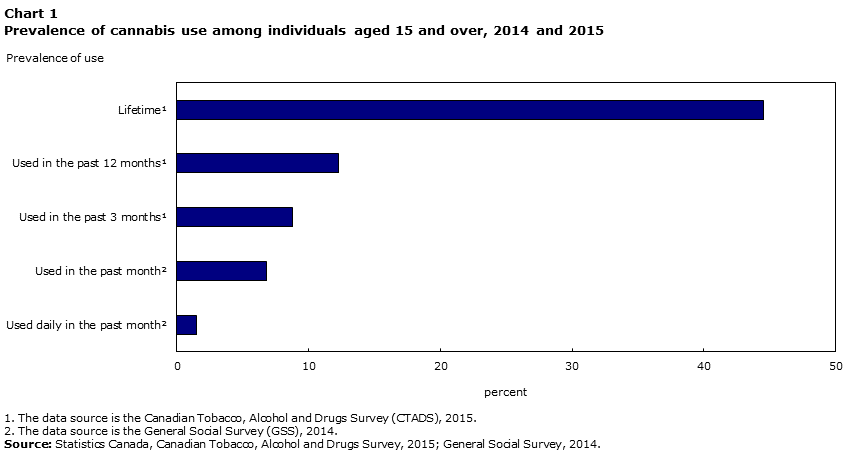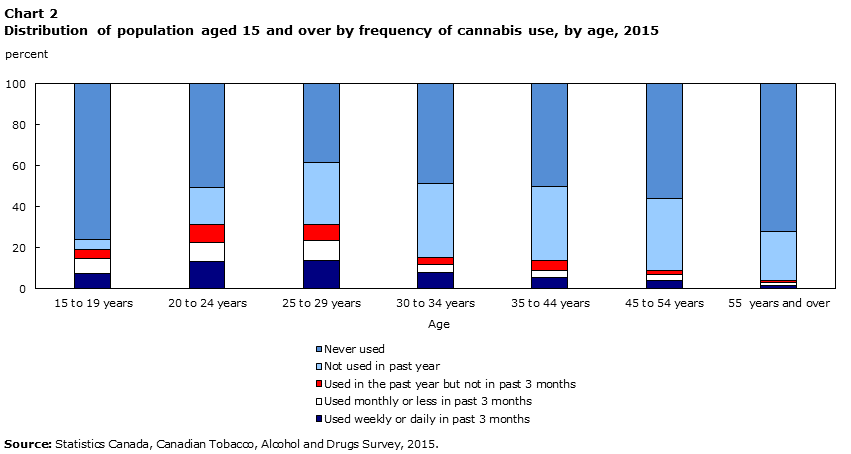This is an old revision of the document!
Table of Contents
Cannabis
Introduction
History
Demographics and Prevalence of Cannabis Use
The United Nations Office on Drugs and Crime (UNDOC) has reported that in 2015, the highest prevalence of cannabis use was in North America, Western Central Africa, as well as Oceania (WHO, 2018). Specifically, from the years of late 1960s to 2015, there is seen to be periods of an increase in the use of cannabis and a decrease in Canada (Statistics Canada, 2017). For example, during the time of 1960s and early 1970s, an increase of consumption was seen in the ages of 15-24. However, this then started to decline in the 1990s, but gradually increased within the 2000s (Statistics Canada, 2017). Overall, there has been a general increase in the usage for the entire age population. Furthermore, a recent report has shown that high school students in Ontario use cannabis as the most used illicit drug (Statistics Canada, 2017). It is seen that in a sample of individuals of aged 15 and over, around 45% of them said that they had tried to use cannabis at least once in their lifetime. From the Canadian Alcohol and Drug Use Monitoring Survey (CADUMS) conducted by Health Canada, a survey was conducted from individual’s ages over 15 within 10 provinces and was conducted over the year of 2015 from volunteers (Statistics Canada, 2017).
From these individuals who have used cannabis, it is seen that the use is not equally distributed as those who have used cannabis within the year of 2015 were in their 20s and then decreases steadily as the age increases. In those who are over the age of 55, majority have not used cannabis within the past year. Furthermore, it has been reported that 48% of men has used cannabis at least once in their life and 32% of women has used it once (Statistics Canada, 2017).
Short-term Effects of Cannabis
The short-term health effects from Cannabis can include positive and negative effects. The positive effects include ones such as:
- Relaxation
- A feeling of euphoria
- Sensory experiences such as a greater sense of sight, taste, smell, and sound (Government of Canada, 2018)
However, negative short-term effects can include:
- A feeling of fear or anxiety
- Inability to concentrate, remember certain tasks, or pay attention
- State of confusion (Government of Canada, 2018)
The smoke from cannabis can also cause a decrease in blood pressure and can damage blood vessels from the inhalation of smoke. Furthermore, those who use cannabis can have delusions or hallucinations so it is advised to be aware of any of these effects on the body (Government of Canada, 2018). It is not possible to overdose from marijuana, however, they may experience panic attacks as well as become paranoid which can lead to injury (NIDA, 2018).
Diagnosis
Pathophysiology
Beta-Amyloid Plaque:
Tau Protein and Neurofibrillary Tangle:
APO-E, Genetic Promotor:
Drugs and Medication
Current Treatments
Cholinesterase inhibitors:
N-methyl-D-aspartate (NMDA) antagonists:
Combination Therapy:
4 Pillars of Alzheimer's Prevention
Pillar 1: Diet and Supplements
Pillar 3: Yoga/Meditation
Pillar 4: Psychological Well-Being
Management
Long-term effects & benefits
Positive Effects
Research shows that the chemical compounds from Cannabis contain numerous pharmacological activities including antimicrobial, anticonvulsant, and anti-inflammatory effects, among other possible benefits (Ramirez, 2016). The endocannabinoid system involves the receptors, CB1 and CB2 which can be found in various organs throughout the body (Smith & Wagner, 2014). CB1 receptors are primarily located in the brain while CB2 receptors, which are involved in the immune system, can be found in the GI tract, liver spleen, and reproductive system (Smith & Wagner, 2014).
In terms of medicinal uses and pain management, various studies have identified that the endocannabinoid system plays a key role in psychiatric disorders such as anxiety, depression, bipolar disorder and schizophrenia as well as developmental disorders, including the autism spectrum disorder (Smith & Wagner, 2014). The literature also identifies clinical endocannabinoid deficiency as a root cause of the pathophysiology of migraines, fibromyalgia, and irritable bowel syndrome. Furthermore, cannabis consumption can alleviate nausea in chemotherapy patients, chronic pain symptoms as well as tics and muscle spasms in patients with Multiple Sclerosis and Tourette syndrome (Webb & Webb, 2014).
Between 2010 and 2011, Webb & Webb (2014) conducted a questionnaire to determine the efficacy of medicinal cannabis use for chronic pain in 100 patients. The response rate for the survey was 94%, and the findings showed a 64% relative decrease in average pain according to a 0-10 pain ranking scale. Additionally, 50% of patients reported a decrease in stress and anxiety and 45% said they no longer had trouble sleeping.
While the connection between cannabinoid receptors and these conditions has been well-established, the therapeutic benefits of cannabis use have not been tested as extensively due to governmental regulations and production restrictions in numerous countries (Smith & Wagner, 2014).
Negative Effects
The long-term effects of cannabis have not been studied extensively due to the substance being illegal in most countries. The potential negative long-term effects that have been identified in in the literature are primarily associated with early and regular consumption of cannabis in adolescents (Gruber et al., 2003).
A meta-analysis of over 6000 participants determined a correlation between early non-medicinal cannabis use in individuals under the age of 15 and an increased risk of dropping out of school and/or attaining a lower level of education (Hoch et al., 2015). Furthermore, early heavy consumption of cannabis, in combination with other potential environmental and genetic stressors such as trauma and abuse in childhood or a predisposition to psychosis, has been associated with an increased risk of psychotic disorders such as schizophrenia (Hoch et al., 2015).
Conclusion: Future of Cannabis
Legal Status
Countries that have legalized the medical use of cannabis (prescribed by a physician) include: Australia, Canada, Chile, Colombia, Croatia, Cyprus, Czech Republic, Finland, Germany, Greece, Israel, Italy, Jamaica, Luxembourg, Macedonia, Malta, the Netherlands, Peru, Poland, Portugal, the United Kingdom, and Uruguay (Kalvapalle, 2017).
Countries such as Brazil and France, have more regulations recording cannabis consumption and only allow the use of specific cannabinoids, such as Sativex. In Canada, Uruguay, the Netherlands and Spain, cannabis can be obtained without a medical prescription, whereas in the United States the legal status of cannabis varies by state (Kalvapalle, 2017).
Cannabis Research
Texts from Ancient Egypt and China illustrate the use of the cannabis plant for numerous purposes including the use of hemp seeds as sustenance and medicinal practices. Ancient texts describe the use of medical cannabis for relieving pain from hemorrhoids as well as rheumatism, gout and constipation.
Despite the widespread documentation of the substance, controlled studies on cannabis use as medicine in a clinical setting is low in prevalence. With the legalization of cannabis in Canada, a G7 country, as of October 17 2018, advocates of the substance hope that government regulations worldwide still become less strict regarding cannabis production, distribution and consumption. As cannabis becomes more widely accepted for medical purposes, this can lead to increased opportunities for research funding, more controlled studies, the discovery of novel uses for medical cannabis, safer drugs on the market and a cultural shift in attitude towards the substance.

